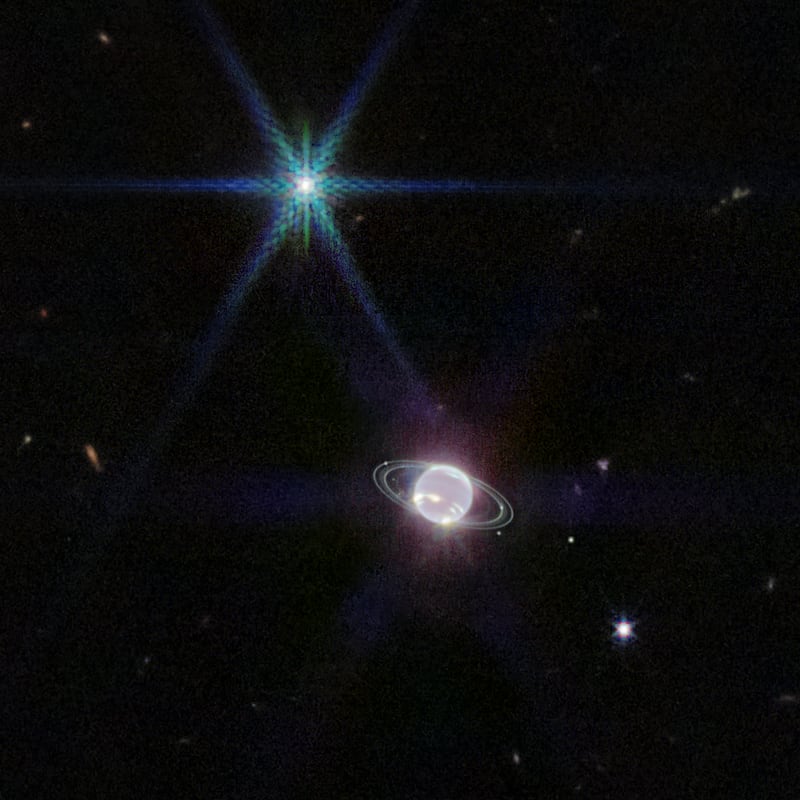Nasa has released new shots of Neptune, the solar system’s outermost planet, taken by the James Webb Space Telescope.
The pictures, taken in July, show not only Neptune’s thin rings, but its faint dust bands, never before observed in the infrared, as well as seven of its 14 known moons.
Webb showed Jupiter at its best in a series of fresh photos released last month.
Launched less than a year ago, the telescope is spending most of its time peering much deeper into the universe. Astronomers hope to see back to almost the beginning of time when the first stars and galaxies were forming.
Actor Armie Hammer resurfaces as host of celebrity podcast
Heart-stopping Halloween terror: 13 of cinema’s greatest jump scares
Doctor Odyssey’s core message: just imagine Pacey from Dawson’s Creek holding you tight and saying, ‘Shhh, it’s okay’
Conor Niland’s The Racket nominated for William Hill Sports Book of the Year
Nasa’s Voyager 2 was the first spacecraft to see Neptune in all its gaseous glory, during a 1989 flyby.

No other spacecraft have visited the icy, blue planet. So it has been three decades since astronomers last saw these rings with such detail and clarity, said the Space Science Institute’s Heidi Hammel, a planetary astronomer working with Webb.
Ms Hammel tweeted that she wept when she saw the rings, yelling and making “my kids, my mom, even my cats look”.
Webb is the world’s biggest, most powerful telescope, operating one million miles from Earth. It rocketed into space last December.
The observatory is in good health, according to Nasa, except for one issue. Nasa reported this week that a mechanism on one of Webb’s instruments showed signs of increased friction late last month in one of four observing modes.
Observations are on hold in this one particular observing track, as a review board decides on how to proceed.
Ground-based observatories and the Hubble Space Telescope have taken many images of Neptune in the past three decades. But the Webb’s views of Neptune, taken in July, provide an unprecedented glimpse at the planet in infrared light.
It took just a few minutes for the telescope to image Neptune close up, and an additional 20 minutes to take a wider view, revealing not just the planet but myriad galaxies behind it stretching into the cosmos.
“It’s aesthetically fascinating to see those distant galaxies and get a sense for how small the ice giant appears,” said Klaus Pontoppidan, Webb project scientist at the Space Telescope Science Institute.
Most prominent in the telescope’s view are Neptune’s rings, seen encircling the planet at a slight tilt given its orientation to Earth. The Webb telescope will allow astronomers to measure the reflectivity of the rings, offering an unmatched insight into this remote spectacle. New images could reveal the size and composition of these thin bands, which are probably made of ice and other debris.
“The ring system was absolutely mind-boggling to me,” Ms Hammel said. “I have not seen it in that level of detail since the Voyager encounter in 1989. It just pops right out.”
Across the planet there are bright spots believed to be clouds of methane ice, which rise high into the planet’s skies and can persist for days.
“Nobody really knows what these things are,” said Patrick Irwin, a planetary physicist at Oxford University. “They seem to come and go, a bit like cirrus clouds on Earth.”
The Webb telescope’s future observations could uncover how they form and what they are made of.
Webb images also show seven of Neptune’s 14 moons. The brightest is Triton, the planet’s largest moon, which scientists suspect was captured by Neptune’s gravity early in the solar system’s history.
In infrared images, Triton’s frozen nitrogen surface makes it shine like a star, brighter than Neptune itself, because methane dims the planet in infrared light. Nasa recently declined to send a mission to study Triton, and not much can be gleaned about it from this image.
But future Webb observations should hint at the composition of Triton’s surface and could show changes indicating geological activity.
“Triton is a geologically active world,” Ms Hammel said. “When Voyager 2 flew by, it saw cryovolcanoes erupting. So there is a possibility that there are changes in the surface chemistry over time. We will be looking for that.”
Ms Hammel also thinks a glimpse of Hippocampus, an eighth Neptunian moon, is pictured just above the planet. “It’s very faint, but it’s in the right location,” she said.
These images of Neptune are just the latest in Webb’s tour of the solar system. This week saw the telescope’s first glimpses of Mars, while over the summer it took amazing views of Jupiter.
Much more of our solar system will come under the observatory’s roaming eye, including Saturn, Uranus and even remote icy objects beyond Neptune — such as the dwarf planet Pluto. — Agencies




